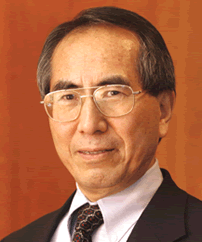2012 Recipients of C&C Prize
Group B

Prof. Hisashi Kobayashi
The Sherman Fairchild University Professor Emeritus of Electrical Engineering and Computer Science, Princeton University
Senior Distinguished Researcher, the National Institute of Information and Communications Technology (NICT)
Citation
For pioneering and leading contributions both to the invention of high-density and highly reliable data recording technology and to the creation and development of a performance-evaluation methodology for computer and communication systems
Achievement
Partial response, maximum likelihood (PRML) is a signal-processing and decoding method applicable to hard disks, optical disks as well as data communication systems. Both PRML and performance-analysis technologies for computer and communication systems have been important in the advancement of information technologies. Prof. Kobayashi made significant contributions to the invention and development of the fundamental principles behind them by creating innovative methodologies utilizing advanced communication theory and mathematics.
Prof. Kobayashi received his Ph.D. from Princeton University in 1967 and then went to work as a researcher at IBM's Thomas J. Watson Research Center, where he worked on high-speed data transmission and high-density, high-reliability magnetic recording. In a band-limited channel, the interference between signals of neighboring digital codes (called inter-symbol interference) becomes very pronounced as the data transmission speed increases. In those days, the development of an automatic equalizer to reduce inter-symbol interference was a major issue for high-speed data transmission. Dr. Kobayashi proposed a novel method to recover data with drastically reduced error rates, even in the presence of inter-symbol interference.
Dr. Kobayashi and Dr. Donald Tang pointed out in 1968 that high-density magnetic recording is mathematically equivalent to high-speed data transmission. Therefore, they proposed applying partial response channel coding, which improves bandwidth utilization by allowing inter-symbol interference. In addition, Dr. Kobayashi found that the maximum likelihood method devised by Prof. Andrew Viterbi as a method for decoding convolutional codes was applicable to decoding partial response signals. As a result, in 1970, Prof. Kobayashi verified by analysis and computer simulation that a combination of the above two methods enabled a significant improvement in the density and reliability of magnetic recording. Prototyping and experimentations of his invented schemes were carried out by a research group of IBM Zurich Research Lab.
The resultant method for achieving high density and high reliability in digital recording devices through the application of advanced communication theories came to be known as PRML. It has been adopted in almost all magnetic as well as optical recording storage and memory since IBM released the 5.25-inch hard-disk drives (HDD) in 1990. For this contribution, Prof. Kobayashi received, together with Dr. Francois Dolivo and Dr. Evangelos Eleftheriou of IBM Zurich Lab., the 2005 Technology Award from the Eduard Rhein Foundation of Germany.
In 1971 Dr. Kobayashi was appointed Manager of the then newly established System Measurement and Modeling Group at the Thomas J. Watson Research Center. He played a leading role in the research of analytical methods for computer performance evaluation and prediction.
In the early 1970s, researchers paid a great deal of attention to application of Markovian queuing network models for the performance evaluation of computer systems. Dr. Kobayashi applied a diffusion process approximation to a non-Markovian queuing network model as an analytic technique to evaluate a multi-programming system with virtual memory. Moreover, he pointed out that the diffusion approximation method was very useful for the analysis of multiple-access communication systems as well.
A computationally efficient algorithm for the normalization constant is important for performance analysis that adopts a queuing network model. Dr. Kobayashi developed practical computational algorithms based on convolutional algorithms and the Polya theory of enumeration, and made theoretical contributions to the development of the first software packages for performance analysis, called QNET4 and RESQ, which were developed by Dr. Martin Reiser and other members in Dr. Kobayashi’s Group.
These results influenced the computer performance community worldwide. Thus, since the mid-1970s, performance analysis techniques using queuing network models were largely developed based on the methods pioneered by Dr. Kobayashi and his associates. For these contributions, he received an IBM Outstanding Award in 1975, elected to Fellow of the IEEE in 1977, and received a Humboldt Prize in 1979. In 1978 he published an authoritative textbook in this field “Modeling and Analysis: An Introduction to System Performance Evaluation Methodology” (Addison Wesley). He also served as the Founding Editor-in-Chief of an international journal “Performance Evaluation” (North-Holland/Elsevier) from 1980 to 1986. Therefore, he has made significant contributions to the establishment of this field of research and to the dissemination of its knowledge.
He served as Dean of the School of Engineering and Applied Science at Princeton University from 1986 to 1991. He has been serving as an advisor to a number of universities and research organizations in the world. He has also been playing a pioneering and leadership role as a Japanese researcher in this age of globalization.
His research accomplishments in the high-density recording technology for storage devices and in the performance evaluation methodology for computer systems were major factors leading to the advancement of research in information and communications technology. Thus, the NEC C&C Foundation highly praises Prof. Kobayashi for his worthy contributions to the advancement of research and development.
